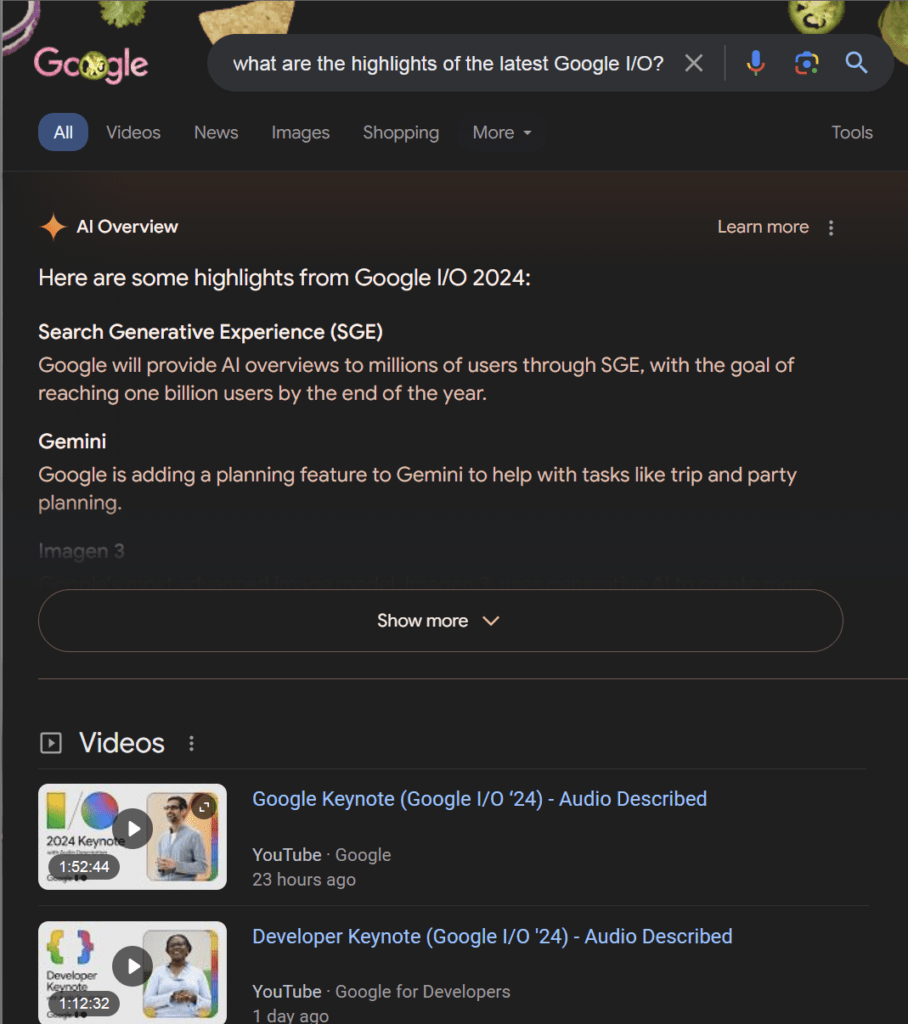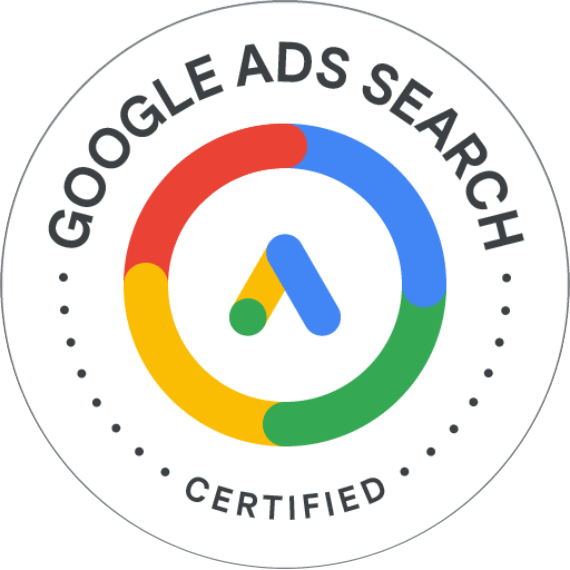How to Optimize for AI Overviews in Google Search?
Date : June 1, 2024 By
Contents
- 1 What are AI Overviews, and How Do They Change the Search Experience?
- 2 Key Factors Influencing AI Overviews
- 3 GEO (Generative Engine Optimization) for AI Overviews Optimization
- 4 Optimization Strategies for AI Overviews
- 5 Tools and Practices for Monitoring Content Performance in AI Overviews
- 6 Conclusion
What are AI Overviews, and How Do They Change the Search Experience?
The recent Google I/O event quickly became one of the biggest news stories of this year for the SEO community with the introduction of AI Overviews for all U.S. users. AI Overviews was in an experimental phase as the Search Generative Experience (SGE), and now it begins its implementation as the next step in Google’s search engine evolution.
AI Overviews represent a combination of generative AI engines that offer highly personalized results as a primary response to various search queries. This feature’s main goal is to provide a custom-tailored and accurate experience for end users with the help of the latest Gemini large language model.
Here is what Google itself claims when it comes to use cases for AI Overviews:
“Find what you’re looking for faster and easier with AI Overviews in search results. AI Overviews can take the work out of searching by providing an AI-generated snapshot with key information and links to dig deeper.”
AI Overviews are positioned at the top of a search results page, with the generative AI response taking up most of the screen space. They include the answer to the original question, as well as several other capabilities – citations, sources, follow-up questions, images, videos, and even product pages or scheduling appointments.

The screenshot above offers a very basic version of the AI Overviews in its current state. This is only a response to a basic query, which includes a generated text response and a separate section for the video materials.
There seem to be at least three different search response types in the AI Overviews:
- Information Search.
- Shopping Search.
- Local Search.
The Information Search regularly responds to most of the questions, the Shopping Search provides Google’s standard format of items that can be purchased, if possible, and the Local Search offers answers based on the end user’s geolocation—including recommendations, directions, and so on.
The release version of the feature in question is still in the early stages of deployment and is limited to U.S. residents for the time being. However, it has been in the development phase for long enough to gather some information about how it changes the existing SEO metrics – traffic, search behavior, etc.
Some of the most important metrics include:
- The overwhelming majority of SGE results (85.5%) provide links to at least one of the top 10 results in traditional search results. At the same time, there are also plenty of sources and information taken from websites that are well outside of the top 100 in search ranking (source: SE Ranking).
- SGE as a feature is not present in every single response, and its appearance frequency dramatically differs depending on the industry: up to 99% for the beauty industry, down to 47% in the finance industry, and with an average of 82% for all of the queries (source: ZipTie).
- Queries triggering Featured Snippets (another older Google feature) are more likely to trigger AI Overviews now. Additionally, more information about the probability of AI Overviews per industry is also revealed, with healthcare generating AIOs in about 63% of use cases, while the B2B technology industry only has a 32% trigger rate, and e-commerce is even lower – 23%. (source: BrightEdge).
- The overall chances of SGE appearing in search results seem to be extremely low by now, with 0.57% on mobile and 0.48% on desktop devices. (Search Engine Journal).
- There is also information that shows the increase in total impressions, total traffic, and average CTR across the board after AI Overviews were turned on. The SaaS industry has shown a 4.42% growth in total traffic, the fintech industry gained 4.27% in average CTR, and the B2C sector seems to be the only one going down, losing 0.03% of total impressions in a week. To be fair, most of these changes can still be attributed to natural curiosity or seasonality, but the vital information here is that the impact of AI Overviews on SEO right now is minimal.(source: SiegeMedia).
Key Factors Influencing AI Overviews
Google claims that the benefits of AI Overviews are available to everyone by default, but the algorithm for choosing specific responses is still largely unknown.
At this time, we know that AI Overviews prioritize a well-structured, “question-answer”-like type of information with the ability to expand upon the topic if necessary. With the AI Overviews release, there seems to be a much bigger focus on highly specialized and genuinely relevant content – including long-tail keywords, as they are much closer to natural language questions than regular keyword combinations. Here is an example keyword – “how to find a cost-effective and reliable backup solution for a company of 30 people using virtual machines with MySQL databases without an existing security infrastructure”.
Potentially important ranking factors for AI Overviews include:
-
Content organization
Content organization is beneficial for assisting AI in identifying how different elements in a sentence or paragraph fit together. This becomes even more important with complex AI tasks (data retrieval, for example), putting a more significant emphasis on content structure as a whole, with well-defined headings, subheading structures, paragraphs, bold highlights, structured data formats, and so on.
-
Content relevance
Content relevance would also be a factor worth considering since AI Overviews often deal with far longer and more detailed questions than regular search queries. In this context, the topic of relevance implies that the long tail keywords or keywords in the form of natural language questions will play a much more significant role in content ranking via AI Overviews.
-
Content quality
Content quality of content is another important factor since the goal of AI Overviews is to present clear and concise answers to the user’s query. Google strongly emphasizes content that was created to benefit the reader and not just boost a search engine’s rankings. This includes the insightful nature of the content, its originality, and a comprehensive coverage of the topic with the usage of the E-E-A-T principles.
GEO (Generative Engine Optimization) for AI Overviews Optimization
A lot of the existing web content is SEO-optimized. SEO uses multiple methods to rank a particular website higher than others in SERPs (search engine results pages). Since 1999, it has been debated what SEO primarily relies on, whether it is backlinks, high-quality and helpful content, technical optimization, behavioral metrics, or other ranking criteria discussed over the years.
Subsequently, the rise of LLM-assisted search features introduced a completely new paradigm called GEO, or Generative Engine Optimization. GEO significantly differs from SEO since it uses other factors to improve the website’s content visibility in the eyes of a large language model such as GPT, Gemini, LLaMA, Claude, and others.
With the release of AI Overviews, the combination of SEO and GEO ensures the best possible visibility across both GEO-focused and traditional search results. GEO-oriented strategies claim to “improve visibility by up to 40% in experiments on deployed commercial generative engines”, and GEO itself also has its metrics and benchmarks to help evaluate the results of various GEO-oriented practices. The metrics showcased on GEO’s website show at least three different ways to improve the visibility of your content in LLMs:
- The correct resource citation with a hyperlink in your content can improve its visibility by up to 132.4%;
- The addition of statistical information to your content can offer up to 65.5% improvement, even without the hyperlink to the source;
- Using authoritative wording is also a surprisingly effective approach, offering an 89.1% improvement relative to the original.
Optimization Strategies for AI Overviews
It should be noted that the entire field of AI Overviews is still very fresh, which means that current strategies are temporary and can be subject to change in the future as more information appears. As an example of this dynamic environment, one of the first pieces of information after the official launch of SGE was the fact that its overall coverage was significantly scaled down (according to ZipTie’s Co-Founder Bartosz Góralewicz). At the same time, most of the test results over the past year were conducted based on a much higher SGE coverage by default.
Therefore, it is wise to optimize several content pages using the new AI Overviews-oriented optimization and monitor their results over a specific period. This experiment should make it evident whether adopting the same logic for more content in the future would be worth it.
Nevertheless, there is enough information already about the current state of AI Overviews that might give a few ideas on how to optimize for better visibility in them. Many of these suggestions are based on my experience in the field, GEO recommendations, and general logic.
Improved value of the content
This includes the emphasis on unique and helpful content that offers value to the end-user and the usage of conversation-focused content since the introduction of AI Overviews is turning many queries into natural-language questions, such as “What should I pack for a vacation in Turkey?”
Adding an expert’s opinion about the topic of the question will also matter a lot in the eyes of Google’s search engine. The same logic applies to correctly placing high-quality and authoritative backlinks – links taken from websites that have shown themselves as relevant, trustworthy and with valuable content over the years. These kinds of links are often used to signal the end user’s content value.
A significant portion of the existing data analysis seems to indicate that many SEO practices still work for AI Overviews optimization. This includes:
- Mobile responsiveness;
- Core web vitals optimization;
- Authoritative backlinks;
- Structured data usage;
- Content formatting, and so on.
Significant focus on E-E-A-T
Google has placed a greater emphasis on E-E-A-T in its search algorithms, and the introduction of AI Overviews relies even more on these four factors:
- Experience.
- Expertise.
- Authoritativeness.
- Trustworthiness.
Identifying and validating an author’s credentials, personal experience, and connection to the topic is a massive advantage in the eyes of the search engine. This includes the author’s industry credentials, an easy-to-find history of successful projects, clear and concise information about the author’s position in the company, a link to another veritable resource such as LinkedIn, and so on.
The usage of GEO
As we have mentioned before, GEO’s existence offers a somewhat defined pathway for the future, with a more significant emphasis on factors that are more pronounced with this strategy.
GEO relies on several practical tactics in its logic, including:
- A strong emphasis on citing resources and quoting from the original.
- The usage of statistical parameters.
- Business-oriented authoritative speech patterns.
- A significant reliance on different forms of multimedia, such as videos and infographics, to present the same content
These factors have already been listed on the GEO website as their most valuable.
Tools and Practices for Monitoring Content Performance in AI Overviews
AI Overviews were introduced a week ago, and the entire SGE testing phase lasted only a year. Since Google itself claims that the AI Overviews will be seen as an evolution of the existing search engine ruleset, they would not be introduced into the Google Search Console as a separate category.
However, there are still some ways to receive at least partial information on the subject. For example, a dedicated resource called SGE Threat Report from iPullRank offers one-time research for up to 250 keywords. It showcases the percentage of traffic these keywords might lose after deploying the AI Overviews.

An example above is taken from the official iPullRank’s website.
The AI Overviews will evolve significantly over time, which may or may not generate new and better tools for tracking its traffic. Right now, there are few tools and programs to choose from. The existence of AI Overviews will also drastically increase the volume of natural language queries in search results – this requires Organic Search performance tracking to switch from specific keywords to topicsto keep up with the newest changes in the industry.
Conclusion
A new era of search engines is coming—an era that will be significantly influenced by generative AI in multiple iterations. This is a significant shift for the entire search industry, and its influence will only become more noticeable as time goes on and AI Overviews become more prevalent.
In this context, a proactive approach from both content creators and SEO specialists is necessary. However, it is somewhat challenging to keep up with the newest changes right now – and SEO would have to keep up optimizing content for new and improved AI-oriented algorithms. On the other hand, a successful adoption strategy would be able to bring an unprecedented level of search visibility.
Some of the most apparent recommendations that could be garnered from this article are:
- Create a clear and concise structure for the existing content.
- Generate high-authority relevant backlinks.
- Research and implement long-tail keywords in your content.
- Improve core web vitals and loading speed.
- Utilize structured data formats.
- Use more multimedia content for presentations and other tasks.
- Keep track of all the new implementations and their performance.
- Stay up-to-date with the latest developments in fields such as GEO, and Google’s news about AI Overviews.
This checklist offers a basic overview of recommendations and actions that could be taken to position themselves better in the modern-world environment with AI Overviews enabled.








